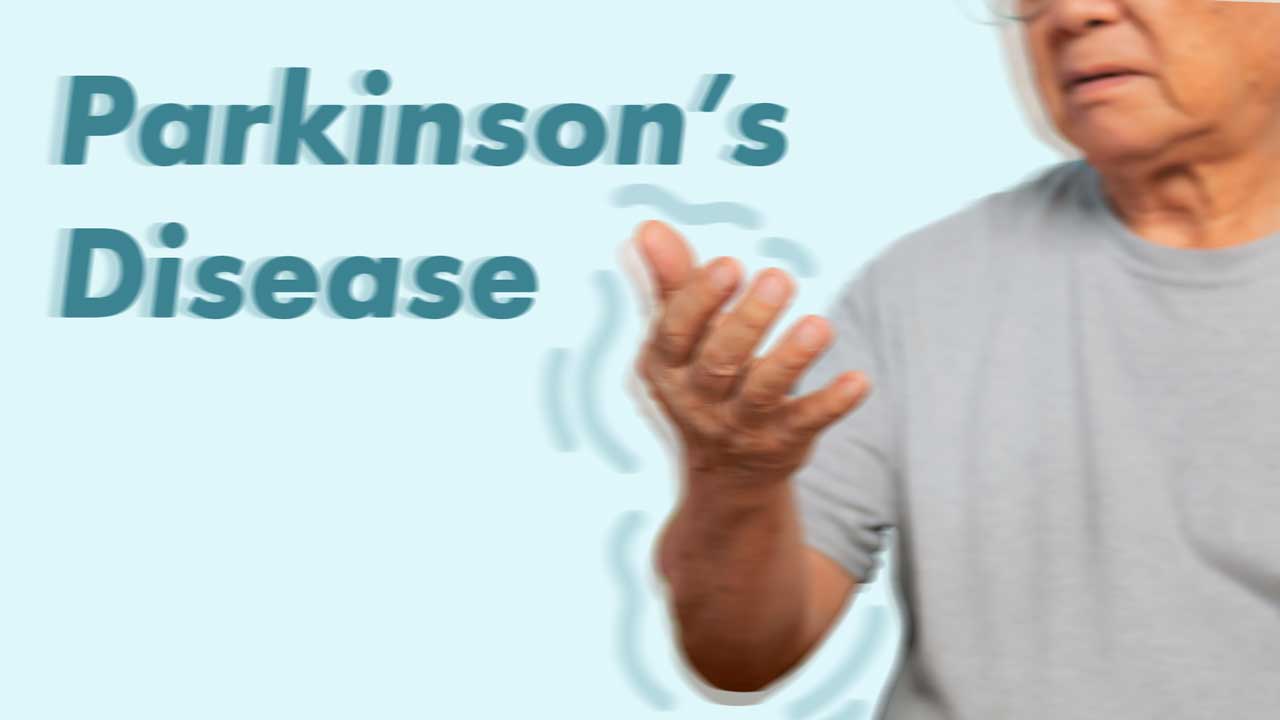What is Parkinson's Disease?
Parkinson’s disease is a progressive neurological condition, marked by both motor and non-motor symptoms.
Parkinson’s disease is the result of deterioration occurring in the nerve cells in the middle area of the brain (parietal lobe), the area in which dopamine is produced (Better Health Channel 2022).
Dopamine relays messages between areas of the brain responsible for body movement, particularly the smooth control of muscles and mobility (Brain Foundation 2024; Healthdirect 2023).
Low levels of dopamine make it difficult to manage muscle tension and muscle movement, both at rest and during activity (Brain Foundation 2024).
Parkinson’s is often understood as a ‘movement disorder’ due to its association with tremors, stiffness and balance problems. However, many non-movement issues also occur as a result of this disease. These non-movement symptoms can include depression, constipation and memory loss (Michael J. Fox Foundation 2019).
As Parkinson’s disease is a progressive condition, its symptoms worsen over time (Better Health Channel 2022).

Parkinson’s Disease Facts
The disease is named after British physician James Parkinson, who first described it in 1817 (Wexler 2023).
It’s estimated that there are close to 219,000 Australians living with Parkinson’s disease (Fight Parkinson’s 2022).
Parkinson’s disease is estimated to impact 8.5 million people worldwide and is slightly more common in men than in women (WHO 2023).
Primarily, Parkinson’s disease occurs in people over the age of 65, but onset can take place earlier (Healthdirect 2023).
Some people with Parkinson's will experience symptoms before the age of 50. This is known as young-onset Parkinson's disease. Treatments are the same, but the experience of the disease tends to differ (Michael J. Fox Foundation 2016).
Causes of Parkinson’s Disease
The exact cause of Parkinson's disease is not yet understood (Better Health Channel 2022).
However, factors that may contribute to the development of Parkinson’s disease include the following (or a combination of these):
- Genetics
- Environmental factors
- Head trauma
- Exposure to chemicals, e.g. pesticides.
(Parkinson’s Australia 2024a; Better Health Channel 2022)
It is thought that only a small percentage of cases (around 10 to 15%) are passed on through genetics (Parkinson’s Australia 2024a).
Symptoms of Parkinson’s Disease
The symptoms of Parkinson’s disease will vary according to type, severity and progression. Some of the main symptoms include:
Motor symptoms:
- Involuntary tremors or shaking, often beginning in one hand or arm
- Muscle stiffness and rigidity
- Slowed movement (bradykinesia)
- Stooped posture
- Freezing (sudden inability to move)
- Difficulty with balance.
Non-motor symptoms:
- Depression
- Pain
- Apathy
- Low blood pressure
- Sleeping difficulties
- Problems with memory
- Problems with urination
- Sexual dysfunction
- Sensory changes
- Changes in the gastrointestinal system.
(Healthdirect 2023; Wexler 2023; Better Health Channel 2022; Michael J. Fox Foundation 2019)

Diagnosing Parkinson’s Disease
At present, there is no singular test for diagnosing Parkinson’s.
However, the following four cardinal symptoms usually lead to a clinical diagnosis:
- Bradykinesia
- Muscle rigidity
- Tremor
- Postural instability.
(Parkinson’s Australia 2024a)
Investigations such as imaging, scans and blood tests may also be performed as part of the diagnostic process (Better Health Channel 2022).
Reactions ranging from anger to disbelief are to be expected from patients when they receive a diagnosis of Parkinson’s Disease. Support and education are integral to overcoming the shock of a Parkinson’s diagnosis. For some, the emotional impact of the diagnosis may outweigh the physical limitations in the early stages (Parkinson’s Australia 2024b).
Managing Parkinson’s Disease
There is not yet a cure for Parkinson’s disease. However, symptoms can be managed effectively by observing the following:
- Medications to increase/substitute for dopamine (levodopa)
- A healthy and balanced diet
- Regular exercise
- Interprofessional treatment such as a combination of therapies, including physiotherapy, occupational therapy, speech pathology and psychology
- Surgical treatments, such as brain stimulation.
(Healthdirect 2023)
Surgical Intervention
There have been multiple exciting developments in surgical responses to Parkinson’s in recent years.
Deep Brain Stimulation
Deep brain stimulation (DBS) is the process of using mild electric impulses to stimulate a chosen area of the brain, such as the thalamus, globus pallidus or subthalamic nucleus (Fight Parkinson’s 2021).
DBS is the primary surgery used for Parkinson’s treatment. Note that this is not a cure but a method of managing symptoms - particularly movement symptoms such as bradykinesia, stiffness and tremor (Fight Parkinson’s 2021).
As a result of DBS, a patient may be able to reduce their medication. To be a candidate for DBS, a person must meet certain criteria. As with all surgery, there are significant risks involved (Fight Parkinson’s 2021).
Lesioning Techniques
Lesioning is the process of making selective damage to certain cells in a specific area of a person’s brain (Fight Parkinson’s 2021).
Lesioning surgery can be an effective treatment, but it isn’t recommended for most people because it may cause irreversible side effects (Fight Parkinson’s 2021).
Rehabilitation of Patients with Parkinson’s Disease
Rehabilitation programs from an interprofessional team including doctors, physiotherapists, occupational therapists, speech therapists, palliative care services and specialist nursing care can be very beneficial for people with Parkinson’s.
Conclusion
Parkinson’s is not considered fatal. However, the progression of the symptoms can considerably reduce a person’s overall quality of life (Wexler 2023).
Multiple effective treatments are available to manage and offer considerable relief for the symptoms of Parkinson’s disease. In some cases, surgery is appropriate. Interprofessional treatment by physiotherapists, neurologists, dietitians and counsellors may be recommended (Healthdirect 2023).
Test Your Knowledge
Question 1 of 3
Which one of the following is one of the four cardinal symptoms of Parkinson’s disease?
Topics
References
- Better Health Channel 2022, Parkinson's Disease, Victoria State Government, viewed 7 October 2024, https://www.betterhealth.vic.gov.au/health/conditionsandtreatments/parkinsons-disease
- Brain Foundation 2024, Parkinson's Disease, Brain Foundation, viewed 7 October 2024, https://brainfoundation.org.au/disorders/parkinsons-disease/
- Fight Parkinson’s 2022, Parkinson’s Prevalence, Fight Parkinson’s, viewed 7 October 2024, https://www.fightparkinsons.org.au/about-us/media-release/parkinsons-prevalence/
- Fight Parkinson’s 2021, Surgery, Fight Parkinson’s, viewed 8 October 2024, https://www.fightparkinsons.org.au/parkinsons-and-you/surgery/
- Healthdirect 2023, Parkinson's Disease, Australian Government, viewed 7 October 2024, https://www.healthdirect.gov.au/parkinsons-disease
- Michael J. Fox Foundation 2019, Parkinson's 101, Michael J. Fox Foundation, viewed 7 October 2024, https://www.michaeljfox.org/parkinsons-101
- Michael J. Fox Foundation 2016, Young-Onset Parkinson's Disease, Michael J. Fox Foundation, viewed 7 October 2024, https://www.michaeljfox.org/news/young-onset-parkinsons-disease
- Parkinson's Australia 2024a, Parkinson’s Symptoms, Causes & FAQs, Parkinson's Australia, viewed 7 October 2024, https://www.parkinsons.org.au/faqs/
- Parkinson's Australia 2024b, Diagnosis, Parkinson's Australia, viewed 8 October 2024, https://www.parkinsons.org.au/information-hub/about-parkinsons/diagnosis/
- Wexler, M 2023, ‘Parkinson’s Disease Overview’, Parkinson’s News Today, 16 October, viewed 7 October 2024, https://parkinsonsnewstoday.com/what-is-parkinsons-disease/
- World Health Organisation 2023, Parkinson's Disease, WHO, viewed 7 October 2024, https://www.who.int/news-room/fact-sheets/detail/parkinson-disease
 New
New 
